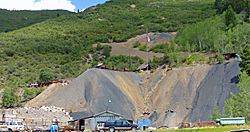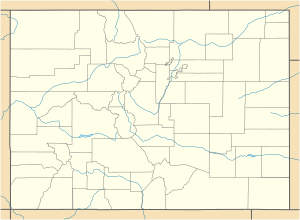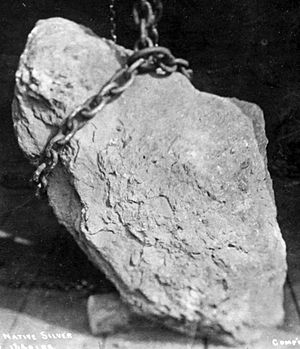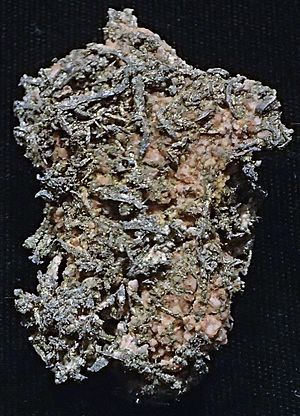Smuggler Mine facts for kids

Mine surface facilities and tailings piles, 2009
|
|
| Location | |
|---|---|
| Location | Aspen |
| State | Colorado |
| Country | USA |
| Coordinates | 39°11′33″N 106°48′23″W / 39.19250°N 106.80639°W |
| Production | |
| Products | Silver |
| History | |
| Opened | 1879 |
| Active | 1879–1918, 1970s-present |
| Closed | |
|
Smuggler Mine
|
|
| Area | 9.7 acres (3.9 ha) |
| MPS | Historic Resources of Aspen MRA, Mining Industry in Colorado |
| NRHP reference No. | 87000194 |
| Added to NRHP | May 18, 1987 |
| Owner | |
| Company | New Smuggler Mining Corp. |
The Smuggler Mine is a historic silver mine located near Aspen, Colorado, in the United States. It sits on the slopes of Smuggler Mountain. This mine is the oldest operating silver mine in the Aspen area. It is also one of the few mines still working from Aspen's early "silver boom" days. In 1987, the Smuggler Mine was added to the National Register of Historic Places.
The biggest silver nugget ever found came from the Smuggler Mine. It weighed about 1,840 pounds (835 kg)! At its busiest time, the mine produced almost one-fifth of all the silver in the world. Its tunnels go more than a thousand feet (300 m) deep. They even stretch under the city of Aspen. Today, many of the lower tunnels are filled with water.
The Smuggler Mine was one of the few mines in Aspen that reopened after 1893. This was when a law called the Sherman Silver Purchase Act was cancelled. The mine kept producing silver until 1918. It then reopened in the 1970s. In 1984, the mine site was named a Superfund site. This happened because tests found high levels of lead and cadmium in the soil. The Environmental Protection Agency (EPA) spent 12 years cleaning up the area. Even though a lot of silver ore is still in the mine, it is now used for tours as much as for mining.
Contents
What Does the Smuggler Mine Look Like?
The Smuggler Mine's buildings are on a 9.7-acre (3.9 ha) area. This area is surrounded by a fence. It is located on the edge of Aspen, at the base of Smuggler Mountain. The mine sits about 8,000 feet (2,400 m) above sea level. The mountain slopes around it have evergreen trees. Other old mine shafts are hidden among these trees.
The mine property has a lower area at the bottom of a large pile of mining waste, called tailings. There is a circular road where vehicles are parked. Another road goes uphill to a group of buildings near a smaller tailings pile. Both of these piles are important parts of the mine's history.
At the bottom of the large pile, you can see a small metal building and a wooden shed. Near the top, there is another metal building and a wooden shed. These newer buildings are not original to the mine's early days. You can also see a modern version of an old wooden ore chute. Next to it are seven ore cars on a track. Two of these cars are from the Smuggler Mine itself. The others are from other mines from the silver boom era.
The original entrance to the Smuggler Shaft is fenced off. The Clark Tunnel is near the upper tailings pile. Both of these tunnels are important historical parts of the mine. The two tunnels lead to 38 underground levels. About half of these levels are now flooded with water.
A Brief History of the Smuggler Mine
Even though people knew the Smuggler Mine had a lot of silver early on, it took a while to fully develop it. But when they did, it became very productive for a few years. This period ended with an economic crisis in 1893. The mine stayed open even as many miners left Aspen. It finally closed in 1917.
How Was the Smuggler Mine Discovered?
In the late 1870s, people called prospectors began looking for silver in Colorado. They crossed the Continental Divide at Independence Pass. Many set up camps where the Roaring Fork River and Castle Creek meet. This area was first called Ute City, after the local Ute tribe. But because of all the aspen trees, it soon became known as Aspen.
The first people to find the Smuggler Mine were Edward Fuller and Con Allbright in June 1879. They are believed to have sold their claim very quickly for supplies. There are not many details because they never officially registered their claim. Legend says they found the mine after losing their blankets in a forest fire. They sold their shares and left the area.
Another story says an unnamed prospector found silver when his shot hit a rock while hunting. He supposedly sold the claim for $50 and a mule. These stories show how exciting the discovery of silver was back then.
It is not clear how Charles Bennett became the first official owner of the Smuggler Mine. He may have thought the claim was abandoned. Bennett claimed he named the mine "Smuggler."
Early Years of the Mine (1880–1886)
Charles Bennett also owned a ranch where the town of Aspen now stands. In 1880, he sold his mining claims and ranch to B. Clark Wheeler and Charles Hallam. These men, along with their partners, formed the Aspen Town and Land Company. They divided the land into lots and sold them for $10 each. This is how the city of Aspen officially began.
Eventually, David Hyman took control of the Smuggler Mine and a nearby mine called Durant. A rich vein of silver ore ran through both mines. This same vein also went into mines owned by Jerome B. Wheeler, who was a co-chairman of Macy's. Hyman and Wheeler had a big legal fight over who owned more rights to the silver. This battle was very expensive and stopped money from being used to develop the mines. They finally settled their dispute by opening a new mine called Compromise Mine.
The Silver Boom Years (1887–1893)
Even with their past legal issues, Hyman and Wheeler worked together to bring railroads to Aspen. This made their mines much more valuable and profitable. The Smuggler Mine's production jumped from $12,414 for all of 1886 to $1,500 in just one day four years later. Both Hyman and Wheeler have buildings in Aspen named after them from this time, like the Hotel Jerome and Wheeler Opera House.
In 1890, a law called the Sherman Silver Purchase Act was passed. This law made the government buy more silver. It greatly helped Aspen's economy. The city's population reached its highest point ever, with over 10,000 people. The new Compromise Mine produced $11 million worth of silver ore. The Smuggler Mine alone produced one-fifth of the world's silver! The mines also produced lead, zinc, and coal. For a while in the early 1890s, Aspen produced more silver than any other city in Colorado. The Smuggler Mine employed over 200 miners.
This time of great wealth ended in 1893. An economic crisis hit, and Congress cancelled the Sherman Silver Purchase Act. The price of silver dropped quickly. Many of Aspen's mines had to close. The Smuggler Mine stopped most of its operations and laid off 70 miners.
Life After the Boom (1894–1917)
At first, people thought the hard times would not last long. In 1894, the largest silver nugget ever was found deep inside the Smuggler Mine. It originally weighed 2,340 pounds (1,060 kg). But it was too big to bring out whole. It was broken into three pieces, with the largest weighing 1,840 pounds (835 kg). The price of silver started to rise a little in 1895.
In 1897, a fire caused the lower levels of the mine to flood. To get the pumps working again, deep-sea divers had to go down and fix them. By 1900, business seemed to be getting better. The Smuggler Mine produced about 250 short tons (227 metric tons) of ore every day. It was not as much as during the boom, but it was steady.
Even when silver prices dropped even lower in 1902, the mine announced it would hire twice as many workers. A local newspaper even predicted "The Return of the Good Times." But Aspen's mines never fully recovered. Flooding almost shut down Smuggler in 1904. All the mine owners had to work together to keep the pumps running. In 1905, 300 miners still worked at Smuggler. However, Aspen's population kept shrinking. By 1910, fewer than 2,000 people lived there.
In 1912, Smuggler's miners went on strike for a short time. They were protesting a pay cut. The strike was settled within two weeks. Mining at Smuggler had been dangerous, with miners often getting hurt or even dying. The miners had formed a union to protect themselves. But Smuggler and Aspen usually avoided the violent labor fights seen in other parts of the state. The miners who stayed were part of the community. They worked with the mine owners to keep Aspen's biggest employer running.
More silver was mined after 1893 than before. But the mining industry could not last forever. After the strike, the cost of pumping water out of the mine cut into Smuggler's profits. In 1917, Smuggler reached the end of its main silver vein. David Hyman decided to close the mine. This was partly due to a disagreement about electricity rates.
The mine's closure was very bad for Aspen's economy. The years after the boom were called "the quiet years." With Smuggler shut down, the 1920s became even quieter for Aspen. Many of the mine's original buildings fell apart or were taken apart for their wood. Besides a little mining, people mostly farmed and ranched. By 1930, fewer than a thousand people lived in Aspen.
The Mine Today (1918–Present)
Mining started again at Smuggler after World War II. Aspen's decline finally stopped, but not because of the mine. In the late 1930s, old mining equipment was used to make the first simple ski lift on Aspen Mountain. After the war, a new, longer chairlift was built. Its opening in 1947 brought important people to Aspen. A new industry, skiing, was replacing mining. The mine's original buildings had not survived. So, new buildings were built after 1950 using wood and metal from other old mines.
Aspen continued to grow. It became a popular place for business leaders and famous people in the 1960s and 70s. In 1981, tests showed high levels of lead and cadmium in the soil on the mountain. These were dangerous wastes from the mining. The Environmental Protection Agency (EPA) was told, and mining stopped for a while.
In 1982, Stefan Albouy bought the mine's operating rights. He hoped to make it profitable again. He started a tradition of firing a cannon from the mine at 6 a.m. every July 4. This continued an old mining tradition of setting off explosives at that time. Sometimes, the cannon is fired for other special events.
The EPA continued to test the soil. In 1986, they added the mine and mountain to their National Priorities List. This made it eligible for cleanup under the Superfund program. Many local people did not like this decision.
Even with the cleanup efforts, Albouy was able to get the mine working again. But he and his partners had money problems. Silver prices were very low. They often did not make a profit. So, the mine had to start offering tours.
Albouy died in 1992. Two of his partners, Chris Preusch and Jay Parker, later bought the mine. They formed the New Smuggler Mining Corporation. They continued both mining and giving tours.
In 1999, the EPA said the cleanup was successful. They removed the mine and mountain from the National Priorities List. The EPA still checks the site every five years. In 2012, Parker and Preusch had to put the mine up for sale. It was listed for $9.5 million. A new owner can choose to keep the mine running. It is believed to still contain about 890,000 pounds (400,000 kg) of silver. Or, the new owner can shut it down for good. If they close it, the New Smuggler company has set aside money for any future cleanup needed.
Images for kids





